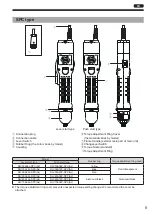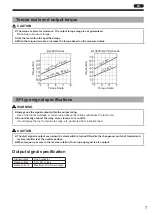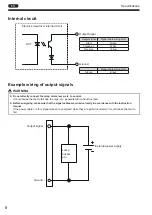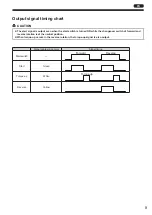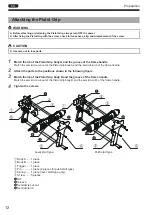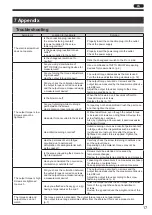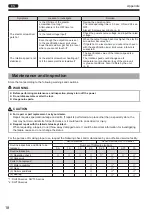
17
EN
7 Appendix
Troubleshooting
Symptoms
Location to investigate
Solution
The electric screwdriver
does not operate
Is the connection plug inserted into
the screw fastening counter?
Is power supplied to the screw
fastening counter?
Properly insert the connection plug into the outlet.
Check the power supply.
Is the power plug inserted into an
outlet?
Is power supplied to the outlet?
Properly insert the power plug into the outlet.
Check the power supply.
Is the changeover switch set to
neutral?
Slide the changeover switch to the R or L side.
The output torque is low
Screws cannot be
tightened
Are you using a combination of
NITTO KOHKI measuring devices for
measurement?
Use a combination of NITTO KOHKI's measuring
devices for measurement. (p. 6)
Are you turning the torque adjustment
ring clockwise?
Has the output torque dropped?
The output torque decreases as the tool is used.
Turn the torque adjustment ring clockwise. (p. 16)
Did you check the correlation between
the output torque occurred on screws
and the output torque measured using
a measurement device?
The output torque occurred on screws and the
output torque measured by the measurement device
are different.
Adjust the output torque according to the screw
fastening conditions. (p. 6)
Is the bit worn out?
When the bit is worn out, it becomes difficult to
transmit torque to screws.
Replace the bit. (p. 10)
Are you tightening while crushing a
part between the screws.
Has regression loosening occurred?
Torque may not be transmitted. Crush the part once
and then tighten the screw.
Has axial force occurred to the screw?
Without axial force, even though the output torque
is increased, screws are not tightened. Review the
screw fastening conditions.
Also, by tightening at low speed, it becomes easier
to transmit torque.
Has initial loosening occurred?
Initial loosening occurs as a result of permanent set
in fatigue when fine irregularities such as surface
roughness are lost over time after the screw is
tightened or outside force is applied. Tighten the
screw again.
Has the permanent set in fatigue
occurred due to permanent
deformation of sealing material such
as the gasket?
Carefully check the screw fastening conditions and
set the output torque.
Depending on the material, torque may not be
transmitted.
Is the area surrounding the screw at a
high temperature?
Screws could be extended or loosened by
temperature changes.
Review the screw fastening conditions and process.
Have you considered the occurrence
of vibration or outside force?
Loosening of screw occurs if no measures are taken
for vibration or outside force.
Take appropriate loosening prevention measures.
The output torque is high
Screws are tightened
too much
Did you check the correlation between
the output torque occurred on screws
and the output torque measured using
a measurement device?
The output torque occurred on screws and the
output torque measured by the measurement device
are different.
Adjust the output torque according to the screw
fastening conditions. (p. 6)
Have you attached a heavy jig or a jig
having a large radius at the end?
After the torque reaches the set torque, the inertial
force of the jig might have been transmitted to
screws.
Review the jig and reduce the weight or size of the
jig.
The torque scale and
output torque do not
match
The torque scale is a standard. The output torque range is not guaranteed.
The output torque range sometimes differs from the scale but this is not a product error.
(p. 7)



